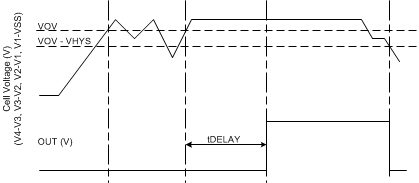SLUSF53 August 2024 BQ2969
PRODUCTION DATA
- 1
- 1 Features
- 2 Applications
- 3 Description
- 4 Device Comparison Table
- 5 Pin Configuration and Functions
- 6 Specifications
- 7 Detailed Description
- 8 Application and Implementation
- 9 Power Supply Recommendations
- 10Layout
- 11Device and Documentation Support
- 12Revision History
- 13Mechanical, Packaging, and Orderable Information
Package Options
Mechanical Data (Package|Pins)
- DSG|8
Thermal pad, mechanical data (Package|Pins)
- DSG|8
Orderable Information
7.3.2 Overvoltage Sensing for OUT
Each cell in the BQ2969 device is monitored independently for an overvoltage condition. Overvoltage is detected by comparing the actual cell voltage to a protection voltage reference, VOV. If any cell voltage exceeds the programmed VOV value, an internal timer circuit is activated. After the timer completes a fixed, pre-programmed delay, the OUT pin transitions from an inactive state to the active state.
 Figure 7-2 Timing for Overvoltage Sensing for OUT
Figure 7-2 Timing for Overvoltage Sensing for OUT